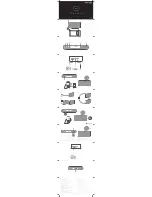
PLM Series Network Configuration Guide
15
REFERENCEs AND DEFINITIONs 7
The following definitions will help the user better understand some specific terms used in this guide, and in other
PLM Series technical documentation. Lab.gruppen has made every effort to make sure that the information here
is correct and accurate.
Term
Description
auto-sensing
The Ethernet ports on the PLM automatically determine the base speed of the network connection (10Base-T or 100Base-T) and configure
themselves appropriately.
auto-uplink
The Ethernet ports on the PLM are able to operate with either straight or crossed network cables. This ability to connect correctly with
either type is termed auto-uplinking.
Backbone
Large Ethernet networks are often implemented with a very high speed “trunk” part of the network topology feeding the main switches,
which in turn support smaller, lower-speed local networks. The term backbone is used to describe such a trunk.
Crossed network
cable
An Ethernet cable in which four of the eight conductors (pins 1, 2, 5 & 6) are not wired pin-to-pin. Such a cable is required in conventional IT
networks to connect two PCs together without using a hub or switch. The auto-uplink feature of the PLM’s Ethernet ports allows crossed
cables to be used if wished. See also Straight network cable.
Differentiated
Services Code Point
(DSCP)
DSCP is a networking architecture that specifies a simple, scalable mechanism for classifying and managing network traffic to provide
Quality of Service (QoS) guarantees on IP networks. DSCP can be used to provide low-latency, guaranteed service to critical traffic such as
audio or video, while providing best effort traffic guarantees to non-critical services such as control or status information.
Dual-network
topology
A network topology consisting of two (usually) identical networks, one connecting to the Primary Ethernet ports and the other to the
Secondary ports. Although more complex to implement, the advantage of using a dual-network system is one of greatly improved reliability
as one complete network remains operational if the other should fail.
Hop
A cable connection from one network port to the next network port.
Latency
The small but finite delay incurred by audio signals when they are transformed into the digital domain, processed digitally, and then
converted back into analog signals. In the Dolby Lake system, latency is assured to be constant.
MaC address
In addition to an IP address, every device on an Ethernet network has a MAC address. This address is fixed at the time of manufacture, and
is effectively the permanent identifier of the physical unit. MAC stands for Media Access Control
Packet
A packet is a formatted block of data consisting of both control data and user data, also known as the payload. Control information provides
data needed by the network to deliver the user data (payload) and assure data integrity. Each packet travels over the network as a discrete
and uninterrupted block of data.
Power over Ethernet
(PoE)
Power over Ethernet is a system for transmitting electrical power over a twisted pair cable along with the data. It is functionally similar to
the phantom powering of microphones over audio cables. PoE allows powering of remote network switches and other appliances without
the need of a separate power supply and AC mains wiring.
Rapid Spanning Tree
Protocol (RSTP)
RSTP is a data communication protocol that enables fast restoration of service following failure or interruptions on a network link. Based on
the old Spanning Tree Protocol, it retains the plug-and-play benefits while providing far faster recovery of network connectivity.
SFP (Small Form-
factor Pluggable)
SFP is an optical transceiver used in data communications. It interfaces a network device to a fiber optic cable, allowing the network to carry
large amounts of data over long distances with minimal latency.
SSID
A Service Set Identifier, or SSID, is used to identify the particular 802.11 wireless LAN to which a user wishes to attach. A client device
receives messages from all access points within range. Selection of the access point can be pre-configured within the client device, or
chosen by a user from a displayed list of SSIDs. Multiple access points will have the same SSID if they provide access of the same LAN.
Star
A network topology which uses a network switch to connect to individual PLMs. Each PLM connects to one port on the switch with its own
cable; thus the network looks like a star when drawn as a diagram with the switch at the centre.
Switch (Ethernet)
An Ethernet switch allows several Ethernet devices to be connected to a network using a star topology. More intelligent than the earlier
hubs (which they now largely replace) , switches route packets of data only to the units for which they are intended, and also perform other
system housekeeping and control functions.
.



































